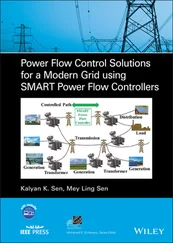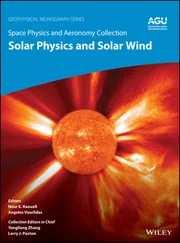Rajiv K. Varma - Smart Solar PV Inverters with Advanced Grid Support Functionalities
Здесь есть возможность читать онлайн «Rajiv K. Varma - Smart Solar PV Inverters with Advanced Grid Support Functionalities» — ознакомительный отрывок электронной книги совершенно бесплатно, а после прочтения отрывка купить полную версию. В некоторых случаях можно слушать аудио, скачать через торрент в формате fb2 и присутствует краткое содержание. Жанр: unrecognised, на английском языке. Описание произведения, (предисловие) а так же отзывы посетителей доступны на портале библиотеки ЛибКат.
- Название:Smart Solar PV Inverters with Advanced Grid Support Functionalities
- Автор:
- Жанр:
- Год:неизвестен
- ISBN:нет данных
- Рейтинг книги:3 / 5. Голосов: 1
-
Избранное:Добавить в избранное
- Отзывы:
-
Ваша оценка:
- 60
- 1
- 2
- 3
- 4
- 5
Smart Solar PV Inverters with Advanced Grid Support Functionalities: краткое содержание, описание и аннотация
Предлагаем к чтению аннотацию, описание, краткое содержание или предисловие (зависит от того, что написал сам автор книги «Smart Solar PV Inverters with Advanced Grid Support Functionalities»). Если вы не нашли необходимую информацию о книге — напишите в комментариях, мы постараемся отыскать её.
Smart Solar PV Inverters with Advanced Grid Support Functionalities
Smart Solar PV Inverters with Advanced Grid Support Functionalities’
Smart Solar PV Inverters with Advanced Grid Support Functionalities — читать онлайн ознакомительный отрывок
Ниже представлен текст книги, разбитый по страницам. Система сохранения места последней прочитанной страницы, позволяет с удобством читать онлайн бесплатно книгу «Smart Solar PV Inverters with Advanced Grid Support Functionalities», без необходимости каждый раз заново искать на чём Вы остановились. Поставьте закладку, и сможете в любой момент перейти на страницу, на которой закончили чтение.
Интервал:
Закладка:
1.1.3.1 Rate of Change of Frequency
The ROCOF is a measure of how quickly the frequency changes following a sudden imbalance between generation and load [9]. ROCOF at any point on the frequency response curve is the tangential line at that point. However, it is usually calculated as the change in frequency over a short period of time, immediately after the sudden loss of generation.
The initial ROCOF after generation loss at t = 0 s is typically calculated as:
(1.5) 
A high ROCOF indicates that the system frequency can potentially fall to a level where Under Frequency Load Shedding (UFLS) may be initiated. ROCOF is used to determine the approximate time required to reach the UFLS threshold. This helps systems planners and operators to provide adequate amount of frequency response within this period to prevent load shedding. It is noted that as soon as the frequency starts to decline, several factors come in to play such as inertial response, load response, and other nonlinear actions which may alter the actual time to reach UFLS [9].
1.1.3.2 Factors Impacting ROCOF
ROCOF is influenced by the following factors [9]:
1 Size of the contingency, i.e. amount of the lost generation or magnitude of power over a major tie line (e.g. HVDC line) from neighboring interconnections or load (for overfrequency events).
2 Total system inertia contributed by synchronous machines (synchronous generators, synchronous condensers, and synchronous motors).
3 Magnitude and the speed of energy injected from generating resources subsequent to contingency.
4 Sensitivity of loads to change in system frequency.
5 Incremental losses in the bulk power system due to modification in power flows after the contingency.
Factors (1), (2), and (3) have a more significant contribution to ROCOF among all the above factors.
1.1.3.3 System Inertia
Synchronous inertia is defined as “the ability of a power system to oppose changes in system frequency due to resistance provided by rotating masses” [14]. Inertia of a synchronous machine is defined as the ratio of stored kinetic energy to the MVA rating of the machine and is expressed as MW‐second/MVA, i.e. in seconds. The inertia constant effectively indicates the time duration over which the kinetic energy stored in the rotating mass will allow the production of rated output of the synchronous machine.
The system inertia, however, represents the aggregation of kinetic energy stored in the rotating masses of all the synchronous machines (generators, condensers, and motors) in the system. This system inertia provides the Synchronous Inertial Response (SIR) to arrest the system frequency as soon as the frequency starts to decline following the loss of a major generation [13].
The system inertia dictates the initial ROCOF as below [9]:
(1.6) 
(1.7) 
where ∆ P loss, loss in generation; KE loss, inertia of the lost generating system; KE sys, total system kinetic energy of the online synchronous machines; H i, inertia constant of the online synchronous machine; MVA i, MVA rating of the i thonline synchronous machine; I , set of all the online synchronous machines.
The above formulation demonstrates that ROCOF is directly proportional to the size of generation loss and inversely proportional to twice the SIR of the system.
In isolated microgrid environments, the relative value of active power exchanged from the DERs in comparison with the remaining generators is high. Hence, the impact of DER generation loss on microgrid system frequency is much larger than in grid‐connected environments.
It is noted that as the penetration of static IBRs (solar PV, wind generators, battery energy storage systems [BESSs]) increases in power systems, the system kinetic energy will decline.
1.1.3.4 Critical Inertia
Critical inertia is defined as the minimum level of system inertia necessary to ensure that frequency responsive reserves have sufficient time to be deployed and prevent the operation of the first stage of UFLS after the largest credible contingency [9]. Critical inertia in an interconnected system is also referred as “inertia floor” for that system.
Critical inertia is dependent on various factors, such as the amount of fast frequency response (FFR) and primary frequency response (PFR) available in the power system, size of critical contingency, the thresholds for initiating UFLS, etc. The critical inertia can be reduced if (i) FFR from loads or other mechanisms can be provided faster, (ii) the thresholds for UFLS are lowered, or (iii) the size of the largest contingency is made smaller.
1.1.3.5 Size of Largest Contingency
The largest credible contingency is described by NERC Reliability Standard BAL‐003 (Resource Loss Protection Criteria) [9]. It is typically the loss of the largest generating unit or a combination of generating units or a large transmission tie line. This largest contingency results in the maximum imbalance between generation and loads.
Larger the size of the contingency, larger will be the reduction in system inertia and consequently, a steeper and more negative ROCOF will be experienced. On the other hand, if the inertia of the lost generator is small relative to the total inertia in the power system, the ROCOF will not be as steep. This will be beneficial for the power system.
1.1.4 Fast Frequency Response
FFR is the power injected into (or absorbed from) the grid in response to changes in measured or observed frequency during the arresting phase of a frequency excursion event to improve the frequency nadir or initial ROCOF [9].
In systems dominated by synchronous machines, FFR is provided by the inertial response of synchronous machines and conventional turbine generator response. The different types of frequency response including inertial response, PFR and FFR, which can act in coordination, are illustrated in Figure 1.8[9].
The beneficial impacts are imparted by both nonsustained inertial response and the sustained FFR and PFR. The sustained frequency response methods provide continuous injection of power until secondary frequency controls bring the frequency back to the scheduled level. It should be noted that the nonsustained response such as inertial response which ceases after a short time period does not adversely impact the frequency during the arresting period or the recovery period. Hence there is a need for inertial response to be coordinated with other mechanisms of FFR and PFR.
FFR can be initiated based on a knowledge of magnitude of frequency deviation, ROCOF, or other factors. There is, however, a delay involved in estimating these quantities which needs to be accounted for. FFR is provided by the following methods, either individually or in combination [9, 15]:
1 Active power injection which is proportional to the measured frequency deviation (proportional response)
2 Injection of fixed magnitude of active power as soon as the frequency reaches a prespecified trigger point (step response)
3 Active power injection that is proportional to the computed ROCOF (derivative response) Figure 1.8 Simultaneous contributions of inertial response, primary frequency response, and fast frequency response.Source: Reprinted with permission from North American Electric Reliability Corporation [9]. This information from the North American Electric Reliability Corporation's website is the property of the NERC and available on the Standards page ( https://www.nerc.com/pa/Stand/Pages/default.aspx). This content may not be reproduced in whole or any part without the prior express written permission of the North American Electric Reliability Corporation.
Читать дальшеИнтервал:
Закладка:
Похожие книги на «Smart Solar PV Inverters with Advanced Grid Support Functionalities»
Представляем Вашему вниманию похожие книги на «Smart Solar PV Inverters with Advanced Grid Support Functionalities» списком для выбора. Мы отобрали схожую по названию и смыслу литературу в надежде предоставить читателям больше вариантов отыскать новые, интересные, ещё непрочитанные произведения.
Обсуждение, отзывы о книге «Smart Solar PV Inverters with Advanced Grid Support Functionalities» и просто собственные мнения читателей. Оставьте ваши комментарии, напишите, что Вы думаете о произведении, его смысле или главных героях. Укажите что конкретно понравилось, а что нет, и почему Вы так считаете.












